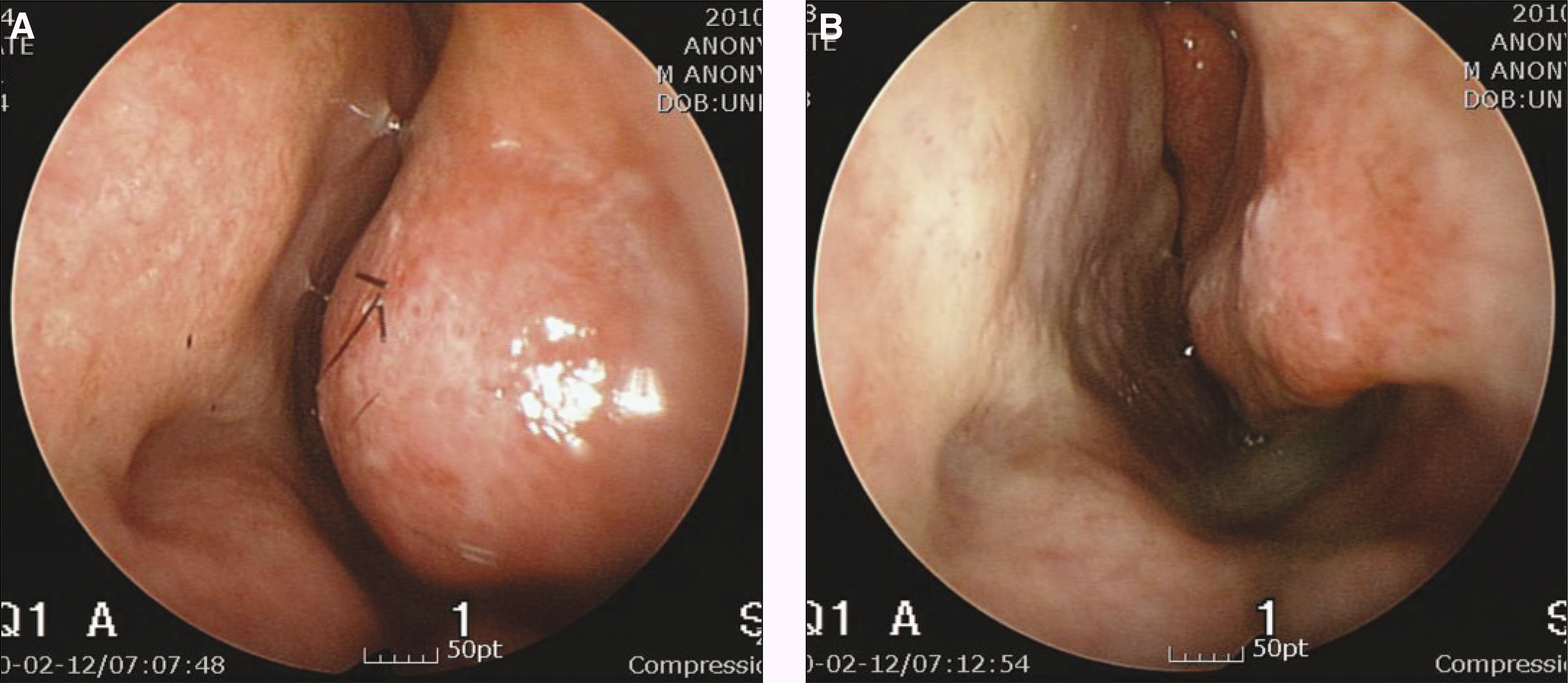Abstract
Introduction
In a surgery of the oral cavity, nasotracheal intubation is often carried out to secure the surgical field. By passing a tracheal tube through the nasal cavity to the pharynx, the nasotracheal intubation can lead to complications that do not occur with oral intubation, such as nasal bleeding and submucosal aberration etc. The purpose of this study is to examine the method of CT evaluation and pretreatment for a safe nasotracheal intubation.
Materials and Methods
Among 30 patients who orthognathic surgery was performed at Chung-Ang University Hospital during the period August 2009 to October 2009, 30 patients were included. The 30 patients were divided into two groups; 15 patients intubated with CT evaluation with pretreatment, and the other 15 patients intubated with no pretreatment. We evaluated nasal bleeding of the two groups during nasotracheal intubation.
Go to : 
References
1. Rogers MC, Tinker JH, Covino BG, Longnecker DE. Principles and practice of anesthesiology. 1st ed.St. Louis: Mosby-Year Book Inc;1993.
2. Collins VJ. Principle of anesthesiology. 3rd ed.Philadelphia: Lea and Febiger;1993.
3. Choi YK, Kim JC, Kim KS, Kang WJ, Kim DS, Shin KI. Effects of balloon on the development of epistaxis and impingement during nasotracheal intubation. Korean J Anesthesiol. 1996; 30:276–81.

4. Stoelting RK, Miller RD. Basics of anesthesia. 3rd ed.New York: Churchill Livingstone;1994.
5. Gravenstein N, Kirby RP. Complications in anesthesiology. 2nd ed.Philadelphia: Linppincott-Raven;1996.
6. Hwang SO, Kang BJ, Kim SK. Does the esophageal stethoscope inserted into the reinforced endotracheal tube decrease the incidence of nasal bleeding following nasotracheal intubation? Korean J Anesthesiol. 1996; 30:271–5.
7. Long TM. Atraumatic nasopharyngeal intubation for upper airway obstruction. Anaesthesia. 1988; 43:510–1.

8. Akog ̆ lu E, Karazincir S, Balci A, Okuyucu S, Sumbas H, Dag ̆ li AS. Evaluation of the turbinate hypertrophy by computed tomography in patients with deviated nasal septum. Otolaryngol Head Neck Surg. 2007; 136:380–4.

9. Uzun L, Ugur MB, Savranlar A, Mahmutyazicioglu K, Ozdemir H, Beder LB. Classification of the inferior turbinate bones: a computed tomography study. Eur J Radiol. 2004; 51:241–5.

10. Hol MK, Huizing EH. Treatment of inferior turbinate pathology: a review and critical evaluation of the different techniques. Rhinology. 2000; 38:157–66.
11. Passa ` li D, Lauriello M, Anselmi M, Bellussi L. Treatment of hypertrophy of the inferior turbinate: longterm results in 382 patients randomly assigned to therapy. Ann Otol Rhinol Laryngol. 1999; 108:569–75.

12. Friedman M, Vidyasagar R. Turbinate Hypertrophy. Bailey BJ, Johnson JT, Newlands SD, editors. Head and Neck surgery: Otolaryngology. 4th ed.Philadelphia: Lippincott Williams and Wilkins;2006. p. 328–30.
13. O'Hanlon J, Harper KW. Epistaxis and nasotracheal intubation-prevention with vasoconstrictor spray. Ir J Med Sci. 1994; 163:58–60.
14. Lee GW, Kim SK, Kim KY. A pulmonary atelectasis due to nasal bleeding after nasotracheal intubation: a case report. Korean J Anesthesiol. 1996; 30:502–5.

Go to : 
 | Fig. 1.We have selected a total of three points, middle turbinate bone tip, inferior turbinate bone tip and a point of the septum. A triangle is formed by linking the points with a line, then a circumscribed circle is drawn around the triangle. We defined R1 as the radius of the circle. |
 | Fig. 2.We have selected a total of three points, on each of the mucosa tip of middle nasal concha, inferior nasal concha, and septum. A triangle is formed by linking the points with a line, then a circumscribed circle is drawn around the triangle. We defined R2 as the radius of the circle. |
 | Fig. 3.Effects of epinephrine pretreatment on the mucosa of the inferior nasal concha. A. Before E-L pretreatment. B. 3 minutes after epinephrine pretreatment. |
Table 1.
Patient characteristics
| Age (yr) | Sex (M/F) | Height (cm) | Weight (kg) | |
|---|---|---|---|---|
| Group 11 | 23.67 (4.47) | 6/9 | 167.15 (8.82) | 61.02 (12.45) |
| Group 22 | 25.46 (2.50) | 2/13 | 165.32 (8.49) | 53.56 (9.70) |




 PDF
PDF ePub
ePub Citation
Citation Print
Print


 XML Download
XML Download